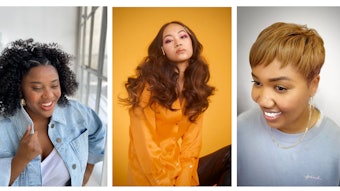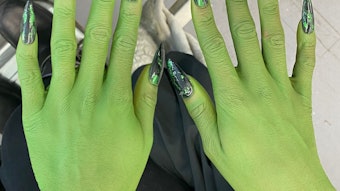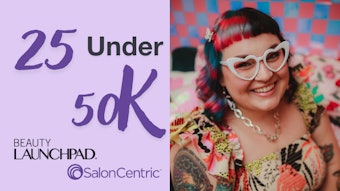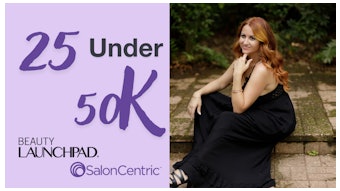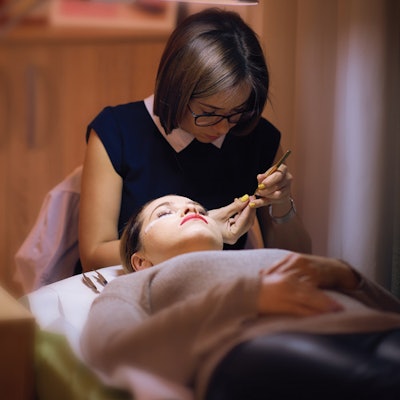
Stop turning a blind eye to your bad habits.
Imagine holding up a book for four-, six- or even eight-hour stretches at a time. Without fail, your arm would eventually start shaking and stiffening up, forcing you to put it down. The same effect happens to your eyes after a day of lashing: they fatigue, resulting in blurred or double vision, tension headaches or dryness. “Since lash professionals perform a significant amount of detail work for long periods of time, their eyes must constantly refocus and use a tremendous amount of power to see,” explains Dagny Zhu, MD, a Rowland Heights, California-based ophthalmologist and cornea, cataract and refractive surgeon. Since the eyes are lash artists’ most valuable tool, they must be protected daily. “Your vision is directly related to the quality of your work,” stresses Lynn La Palermo, master lash artist and educator for Occhi’ Lash & Brow Studio in Oakbrook Terrace, Illinois. “If you have vision problems, you won’t be able to see your attachments and your isolation will be incorrect.”
So how do you know if your eyes are in trouble? “You may notice yourself squinting more often or tilting your head forward or backward to focus,” explains Soo-Jin Yang, founder and CEO of Illumino Lashes. Some factors to blame? “Improper lighting, not using the correct magnification or placing fans without looking up can all cause eye fatigue, blurred vision, burning and/or dry eyes, depth perception disorders, headaches or nearsightedness,” warns Diane Lytle, founder of The Lash Chick. The good news? There are a myriad of ways that you can protect your peepers without compromising the quality of your services. To help, we tapped leading lash professionals for their most coveted advice on vision protection. Here, their top five best practices, along with a roundup of must-have product picks to keep your eyes—and your services—in check.
1) Use Magnifying Lenses: Most lash artists will agree: Magnifying lenses are critical at any age and stage of your career. “Some young lash artists think that because they don’t wear glasses, they don’t need magnification, but that’s incorrect; close-up work requires appropriate eyewear,” warns La Palermo. And while age plays a role—presbyopia, or age-related farsightedness, typically occurs around ages 40-45—not using proper magnification can cause eyestrain at any time. Some easy and ready-available options include reader glasses or magnification lenses. “Magnification lenses often come in a variety of diopters (the optical power of a lens) to accommodate every vision need,” explains Scott Hoonakker, owner and CFO of Premier Lash. In fact, some manufacturers will even customize a set of lenses based on your current vision and the distance of your workspace. A few things to keep in mind when shopping for magnifying lenses: comfortability (traditional frames that sit behind the ear versus a wraparound design) and lighting. “It’s best to attach a headlamp to your magnifiers to provide a precise ray of light for your work,” suggests Yang.
RELATED: 5 Ways for Eyelash Techs to Prevent Eyestrain
2) Ditch Fluorescent Lighting: Improper lighting not only hinders the quality of your services, it’s also the No. 1 contributor of eye irritation. “Our eyes see best with light, so it’s imperative that your workspace has ample illumination,” stresses Dr. Zhu. One of the biggest offenders is fluorescent lighting, which can cause blurred or double vision, headaches and/or dry, sore or watery eyes. Your best bet is a bright light source that features LED bulbs and adjustable settings. “You want the light to cover both sides of the client’s face when she’s laid out on the treatment bed to avoid shadows,” advises Yang. “It’s also important that you select a light that doesn’t get too hot in case you or the client accidentally bump the bulb.”
3) Invest in Ergonomic Seating: Strong posture and ergonomically designed seating both play crucial roles in vision protection. “Lash artists often hunch or lean over in order to get a closer view of the lashes,” notes Erin Meyer, sales manager for Lash Addict. A comfortable and supportive chair is key. “You should be able to adjust the height of the chair so that your vision is in direct alignment with your client’s eyes,” advises Jeannie Owens, founder of Lash Out!. The best available options? Hydraulic chairs, which can be adjusted up or down to best fit your needs; saddle chairs, which reduce pressure on the lower back; and medicine ball chairs, which allow you to sit straight up and—bonus!—help you strengthen your core muscles at the same time.
4) Exercise Your Eyes: Eyes contain muscles, and just like the other muscles in your body, they need to be exercised frequently in order to remain healthy and strong. Dr. Zhu advises implementing the “20-20-20 Rule” to relieve eye strain. “Every 20 minutes, look at an object that’s 20 feet away for 20 seconds,” she explains. Another exercise to implement throughout your workday? “Hold your tweezers a few inches from your eyes, then slowly move them away from your face, focusing on them the entire time,” suggests Lytle. “Look away for a few minutes, then move the tweezers toward your eyes and look away at something off in the distance. Repeat this process five times.” To relieve strain or pain, Meyer recommends applying pressure to the inner eyebrow, the middle of the brows and the temples. Blinking is also an easy exercise to combat dryness. “Store eye drops by your treatment bed to hydrate your eyes in between appointments, or shut your eyes tightly for a minute for instant lubrication,” says Yang. She also recommends applying a warm dry compress to the eyes at night for additional relief.
5) Visit Your Eye Doctor Annually: Much like you get your car serviced every six months to ensure everything is in proper working condition, annual eye exams are necessary to maintaining proper eye health. “Lash artists should visit the eye doctor once a year in order to rule out any diseases that may contribute to eye strain, such as dry eye, which is often under-diagnosed,” warns Dr. Zhu. Lytle also recommends that new lash artists receive an eye exam before they start lashing so doctors can correct any vision or depth perception issues from the start. Plus, it’s always important to get a baseline measure of your eye health before you start working, so if anything changes as time goes on, the doctor knows how to treat you. The bottom line: Your eyes are critical to both your life and your livelihood. If you to want to pursue a long, successful career, then you need to ensure they remain in optimal condition.
RELATED: Genius Strategies for Gaining Engagement From Your Social Posts
Sight Saviors
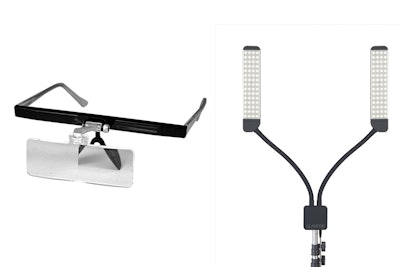
Magni-Specs Premier Lash - Available in six diopters, these lightweight lenses can be worn alone or over eyeglasses for additional magnification.
Classic Elite 2 Glamcor - Equipped with 5,600K LED bulbs, this powerful lighting system features a lightweight design with touch dimming and power controls.
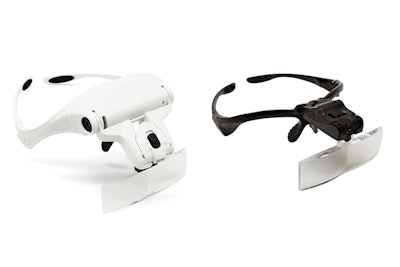
LED Magnifying Glasses Lash Addict - Designed to magnify up to 350 percent, these magnifying glasses feature five interchangeable lenses and a wraparound design for maximum comfort.
Magnifying Head Lamp FantaSea - With adjustable lighting and lens angles, this headlamp can be worn like eyeglasses or as a headband, and features two LED lights, five interchangeable magnifying lenses and a removable lighting piece.
Repeat Offenders
Your day job isn’t the only contributor to poor eye health. Check out three factors that may cause irritation and vision problems.
1) Poor Diet: A diet lacking in vitamins C and E, omega 3s, carotenoids and zinc can lead to macular degeneration (vision loss) and other vision issues, so load up on leafy greens, salmon, carrots and healthy proteins.” —Diane Lytle, founder of The Lash Chick
2) Constant Screen Time: “Since we’re always on our electronic devices (cell phone, laptop, etc.), we’re constantly using our eyes and not giving them sufficient time to rest. —Jeannie Owens, founder of Lash Out!
3) Strong Fumes: “Adhesives with harsh fumes can irritate the eyes, causing redness, pain, tearing or blurred vision. What’s more, direct contact with these chemicals can scratch or burn the cornea, which can scar the eye in rare cases.” —Dagny Zhu, MD, Rowland Heights, California-based ophthalmologist
This story first appeared in the March/April issue of Eyelash magazine. To receive the magazine, click here to subscribe.
[Images: Getty Images; manufacturers]
